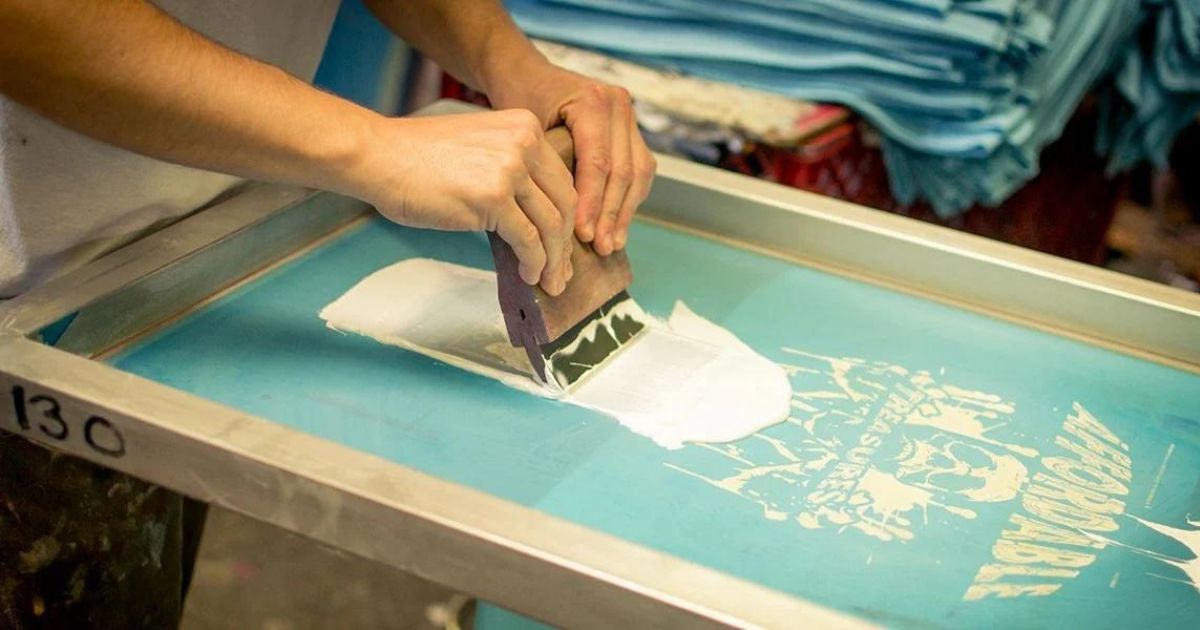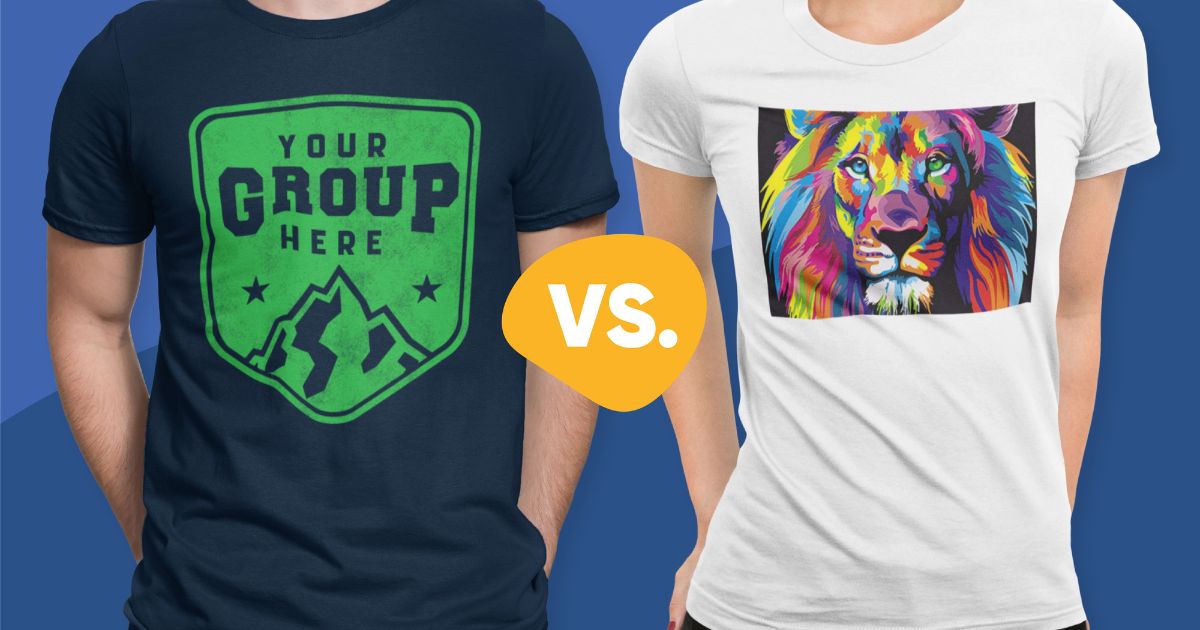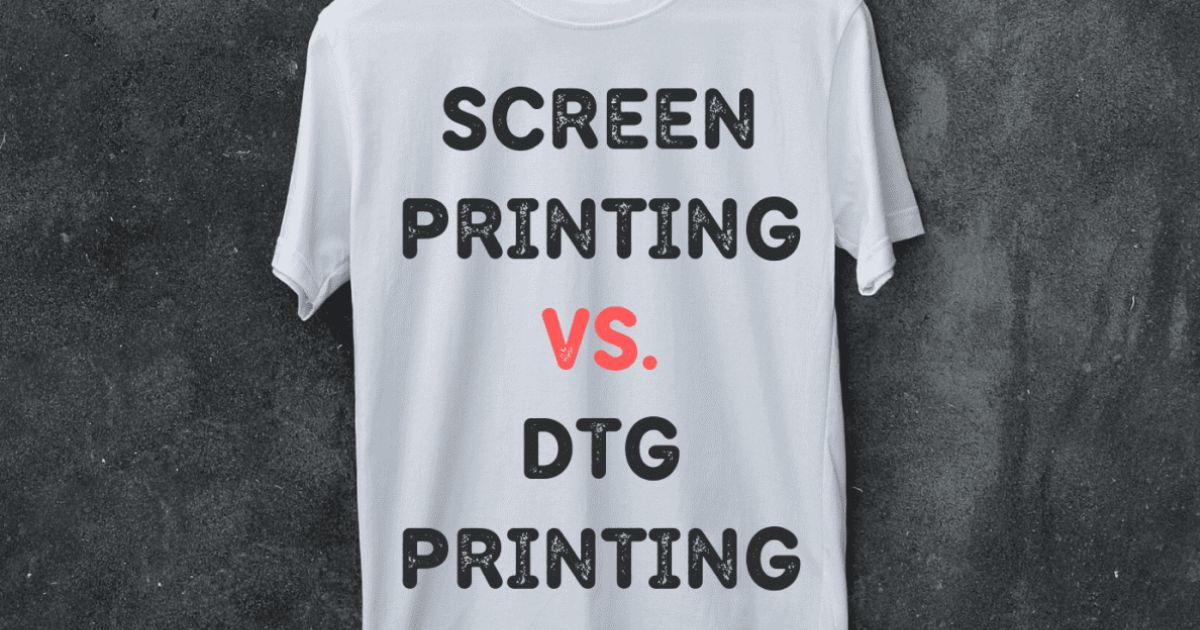Screen Printing vs Digital Printing: Which is Better?
In the vibrant world of textile personalization, two contenders stand out: screen printing vs digital printing. The former, deeply historical, graces many beloved items, like band tees, whereas the latter, a modern method, impresses with affordability and an environmentally conscious angle. Which holds the crown? Delve in to compare the nuances, strengths, and weaknesses of screen printing vs digital printing in contemporary fabric design.
What Is Screen Printing Vs Digital Printing?
As we navigate the evolution of printed textiles, understanding these methods can equip designers and consumers alike with the knowledge to make informed choices. Let’s embark on a journey to explore and contrast these two iconic printing techniques.
Screen Printing
Screen printing, often referred to as silk screening, traces its origins back to ancient China. A craft perfected over thousands of years, it began with artists using silk screens to stencil layers of ink, creating masterful designs. Fast forward to the present day, and the core principles remain, though with modern adaptations.

The contemporary screen printing process utilizes a negative or stencil placed onto a mesh screen, usually made of polyester rather than the traditional silk. This stencil dictates where ink will and won’t go. By pressing viscous plastisol ink through this mesh onto fabric, the design is transferred with precision. Each color requires its own screen, making multicolored designs a more intricate endeavor.
Unlike other printing methods, screen printing places ink atop the fabric, resulting in a distinct, raised design. This tactile experience gives designs a soft yet prominent feel, durable and resilient to wear.
Digital Printing (DTG)
Digital printing, synonymous with Direct-to-Garment (DTG) printing, is the newcomer in textile customization. As its name suggests, this method involves directly printing designs onto fabric. If you’ve ever used a standard office printer, you’ve got the basic idea: it’s a similar concept, but on a grander scale and with fabric as the medium.

DTG employs a set of primary colors: magenta, cyan, yellow, and black. Some advanced versions even incorporate red and green. Through intricate mixing and layering, these base inks reproduce a vast spectrum of hues, allowing for the replication of detailed images and photographs.
The cutting-edge technology behind DTG does come at a premium. These colossal machines, designed to process fabrics with finesse, can range from $15,000 to staggering six-figure sums. But for many commercial entities, the investment is justified. The speed, ease, and design flexibility afforded by DTG make it a sought-after choice, especially when intricate or multicolored designs are in demand.
What is the Difference Between Screen Printing and Digital Printing?
While both aim to transfer striking visuals onto materials, the processes, durability, quality, and complexity of the designs they produce differ considerably. Let’s break down these distinctions.

Application Methodology
At their core, screen printing vs digital printing ( DTG) diverge fundamentally in the way they apply ink to fabric:
- Screen Printing: This ancient art pushes ink onto fabric through a stencil, with each color applied sequentially through individual screens. Think of it as a manual, layer-by-layer application.
- Digital Printing : Leaping into the digital age, DTG uses advanced printers that precisely deposit ink onto the fabric, governed by intricate computer-generated patterns.
Durability
- Screen Printing: Often heralded as the king of durability, screen printing bonds a rich layer of ink with the fabric using a heat curing process. This ensures designs remain vibrant and intact over the years.
- Digital Printing: Though DTG employs a thinner ink, leading to potential fading after numerous washes, the longevity truly hinges on the quality of the print. As with any method, subpar applications might deteriorate quickly.
Quality
- Screen Printing: With its use of vibrant plastisol inks and a foundational white layer, screen printing usually results in visually striking, bold designs. This often grants a higher-end feel, making designs stand out, especially on darker fabrics.
- Digital Printing: Though it may not match the vivacity of screen-printed designs due to its water-based inks, DTG excels in color blending and intricate design application. The level of detail and color gradients possible with DTG might appeal to those prioritizing design complexity over sheer vibrancy.
Complexity
- Screen Printing: While capable of layered and complex designs, screen printing does face challenges with extremely detailed patterns, often requiring modifications to maintain clarity. For instance, halftones – dots used to convey color gradients – are larger and more visible in screen printing, unlike the almost microscopic dots in DTG.
- Digital Printing: DTG emerges as the champion for detailed designs, such as photographs or full-color illustrations. With its ability to capture minuscule details and varying shades, it can recreate intricate patterns, like the nuances of smoke or the delicate structure of lace.
Consistency
- Screen Printing: This more manual technique can occasionally exhibit slight inconsistencies from one batch to another. For instance, minute variations in screen tension or alignment can alter the final design. While some might see these variations as flaws, others appreciate the unique touch of each print.
- Digital Printing: With technology at the helm, DTG (direct-to-garment) printing ensures a high level of uniformity. Computerized systems ensure that the design is reproduced with little to no variation across prints. This method minimizes discrepancies, delivering consistent results for each garment.
Cost Efficiency
- Screen Printing: Though it might be more time-consuming initially, screen printing becomes cost-effective in bulk. The primary costs lie in the setup; once that’s done, producing large quantities is efficient. However, as design complexity or color variation increases, so does the cost due to additional screens and setup time.
- Digital Printing: Ideal for smaller orders or intricate designs, DTG is flexible in its pricing. Whether you’re printing one shirt or fifty, the cost structure remains relatively stable. This is especially true when the design complexity increases, as DTG can manage intricate designs without added cost.
Multi-Color Prints
- Screen Printing: Typically suited for designs with fewer colors, screen printing can handle multi-color prints but at a higher cost and setup time. Each color requires a distinct screen, which can escalate both the price and the production time.
- Digital Printing: DTG shines when it comes to multi-color prints. By mixing CMYK primary colors, a vast array of shades can be achieved, allowing for detailed and vibrant designs without any added complexity or cost.
Color Blending
- Screen Printing: Often more straightforward, screen printing predominantly works with distinct color layers. While it can produce vibrant results, it doesn’t typically delve into the subtle art of color blending as DTG does.
- Digital Printing: DTG excels in color blending by using minuscule dots to craft smooth gradients and nuanced shades. This precision is especially evident in complex imagery, where varying shades are essential to capturing the essence of the design.
Set-Up Time and Cost
- Screen Printing: Demanding a lengthier and more intricate setup, screen printing might come with additional fees, especially for smaller orders. The time-intensive nature of preparing screens, aligning designs, and ensuring color accuracy can influence the cost and production timeline.
- Digital Printing: Though requiring expertise in file preparation and machine operation, DTG’s setup is relatively swift. The primary focus lies in transferring the digital design to the printer and ensuring the garments are positioned correctly.
Quantity
- Screen Printing: Economically speaking, screen printing becomes more cost-effective for larger batches of identical designs. This efficiency arises from the one-time setup; once the initial preparations are done, reproducing the same design becomes cheaper.
- Digital Printing: DTG caters best to smaller quantities and unique designs. Given its low setup requirements and flexibility, small batches or even single shirts can be produced with ease.
Best Fabric
- Both Techniques: Both screen printing and DTG perform optimally on 100% cotton textiles, delivering crisp, durable prints.
- Screen Printing: However, screen printing has a broader canvas, capable of adapting to materials like polyester with some adjustments. This flexibility makes it a preferred choice for custom athletic wear, such as team jerseys, as it bonds well with moisture-wicking fabrics.
- Digital Printing: DTG, on the other hand, is limited exclusively to cotton. When scouting for DTG services, avoid those offering polyester prints, as the quality and durability will be compromised.
Special Effects
- Screen Printing: The traditional method offers a plethora of special effects. Be it the tactile allure of raised puff paint, the shimmer of glitter and metallic inks, or the retro charm of “dayglo” fluorescent shades—screen printing is a treasure trove of creativity. Textures ranging from suede-feel inks to high-density layered 3D designs and even vintage crackle effects can be achieved.
- Digital Printing: DTG, being a more contemporary technique, primarily focuses on precise reproductions rather than special effects. Thus, while it excels in replicating intricate designs, it doesn’t bring the same array of effects to the table.
Purpose-Driven Choices
- Screen Printing: Ideal for bulk orders of consistent designs, screen printing delivers vivid, durable results. The tactile quality of raised inks, coupled with the vibrancy of colors, lends a premium finish. If durability and premium aesthetics are the aim, screen printing is the way to go.
- Digital Printing: Tailor-made for customization, DTG thrives on individual prints. With minimal hassle, it can create intricate visuals that are lighter and softer on the fabric. For those prioritizing comfort and design intricacy, DTG is the answer.
Average Cost Per T-Shirt
- Screen Printing: On average, screen-printed shirts can cost between $5-$9 each, with bulk orders driving the per-piece price down. The retail price typically ranges from $10-$25, influenced by design complexity, brand, and other factors.
- Digital Printing: Printing with DTG is notably affordable, often less than a dollar per piece. While the selling price is influenced by various factors, such as the brand and distribution channel, the average range remains consistent between $10-$25.
Discover the true cost behind your tees! Dive into How Much Does it Cost to Make a Shirt? to uncover 8 deciding factors
DTG vs Screen Printing: Which to Choose?
In the vast realm of garment printing, both Screen Printing vs Digital Printing (DTG) and techniques have carved out distinct niches. Understanding the inherent pros and cons of each method is essential for making informed decisions based on your specific requirements.

Direct-to-Garment (DTG) Printing
Advantages:
- Detail and Complexity: Excellently captures multi-colored, intricate designs.
- Economical for Small Orders: Handles limited quantities without breaking the bank.
- Comfort: Uses water-based inks that permeate the fabric, providing a soft and breathable finish.
Limitations:
- Durability: While reasonably long-lasting, it might not endure as many washes as other methods.
- Brightness and Vividness: Designs might lack the vibrancy, especially on darker fabrics.
- Fabric Constraints: Primarily compatible with 100% cotton for optimum results.
Screen Printing
Advantages:
- Texture and Longevity: The raised designs, often using plastisol ink, offer tactile richness and impressive durability.
- Vibrant Displays: Known for its striking, bright colors and ability to incorporate special effects like metallic or glitter inks.
- Versatility in Fabric: Compatible with both cotton and polyester.
- Bulk Orders: Large quantities with uniform designs can be produced cost-effectively.
Limitations:
- Setup Intensity: Each design demands significant setup, making it less efficient for single or limited prints.
- Multi-colored Designs: Additional color screens can escalate costs and production time.
- Intricate Designs: Although feasible, highly detailed designs require considerable effort and expertise.
Making the Right Choice: Factors to Consider
- For a classic, enduring look, screen printing takes the lead. For intricate, multi-faceted designs, DTG is unparalleled.
- If longevity post multiple washes is a priority, screen printing stands out.
- While screen printing offers a broader canvas including diverse fabrics, DTG is predominantly cotton-centric.
- For smaller batches, DTG is more economical due to minimal setup needs. Conversely, screen printing becomes cost-effective in larger quantities.
In summary, both screen printing vs digital printing have unique strengths tailored for specific scenarios. Whether you’re inclined towards the nuanced artistry of digital prints or the bold, tactile charm of screen prints, understanding their distinctions can guide you towards a choice that aligns with your vision and goals. For those eager to explore exquisite T-shirt designs and gather more insights, a visit to Ricardo Seco Shop‘s website is highly recommended. Dive into a world of fashion expertise and make an informed choice for your next garment print.
